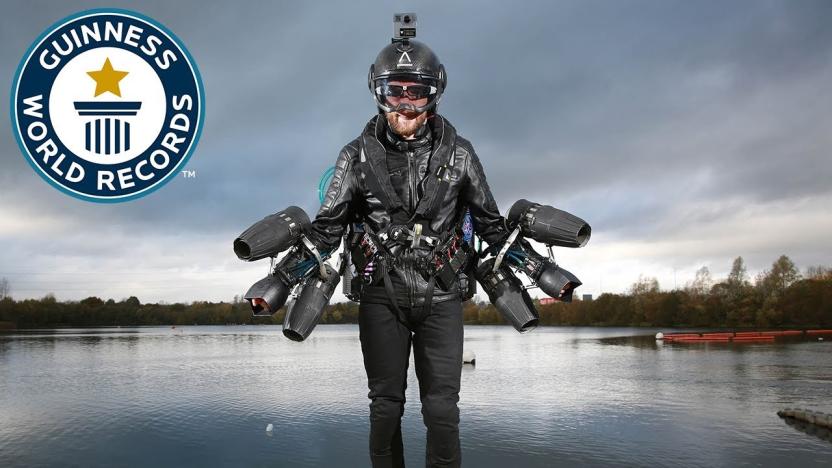TL18JTPK
Latest

Watch real-life Iron Men do the first jetpack launch from the ground
Iron Man might make flying look easy, but strapping on a jetpack and wings ranks as one of the more dangerous things you could ever try. Jetman Yves Rossy and his two protégés (Fred Fugen and Vince Reffet) are bringing you closer to that action with the launch of a documentary called Loft: The Jetman Story.

The guy who built his own Iron Man suit now has a Guinness record
Remember that guy who built a homemade Iron Man suit? Well, with the help of his arm-strapped, gas-powered turbine engines, he just earned himself a Guinness World Record title. As The Mirror reports, Richard Browning and Daedalus (the name of his suit) reached flying speeds of 32.02 mph and Guinness awarded the feat with a title for the fastest speed in a body-controlled jet engine power suit. If you're wondering how many competitors there could possibly be in such a category, the answer is one. Browning is the first title holder.

Boeing offers a $2 million prize for a working jetpack
It's 2017, and as the refrain goes, where are the flying cars? Boeing is more interested in "personal flying devices" -- aka, jetpacks or flying taxis -- and is partnering with new organization GoFly to post a $2 million bounty for working designs. Kind of like an X Prize competition, the partners are giving teams two years to develop their tech before whomever impresses the judges at a "final fly-off" takes home money from the GoFly Prize pool.

Watch a jetpack pilot fly past the Statue of Liberty for the first time
Forget taking a ferry to see the Statue of Liberty... how about visiting with a couple of jet engines strapped to your back? JetPack Aviation chief David Mayman did just that: the entrepreneur is the first person to fly around New York City's signature statue in a "controlled and sustained" way with a jetpack. He wasn't exactly brushing past Lady Liberty's nose, as you'll see in the video below, but it's still a noteworthy feat. Is this ultimately a publicity stunt meant to draw attention to the company's upcoming, mainstream-oriented JB-9 jetpack? You bet. However, there's no denying that this is also a childhood wish come true. It's not often that you can soar above the tourists and still get a good look at one of the US' best-known monuments.

DARPA's jetpack will help soldiers run faster, stronger (video)
We've seen several attempts at making jetpacks that fly, but over at Arizona State University, a team is developing one for those who prefer staying closer to the ground. The DARPA-funded project (naturally) is called 4MM or 4 minute mile, and it aims to develop a jetpack that can provide soldiers that extra boost needed to run a full mile within four minutes. Sure, soldiers are physically fit, but the jetpack will make sure each one can do a 4-minute mile, even if they're not particularly fast runners, and even if they're carrying heavy equipment and armor.

Up, up and down: The ephemerality and reality of the jetpack
Welcome to Time Machines, where we offer up a selection of mechanical oddities, milestone gadgets and unique inventions to test out your tech-history skills. Born out of sci-fi cinema, pulp literature and a general lust for launching ourselves into the wild blue yonder, the real-world Rocket Belt began to truly unfold once the military industrial complex opened up its wallet. In the late 1950s, the US Army's Transportation Research Command (TRECOM) was looking at ways to augment the mobility of foot soldiers and enable them to bypass minefields and other obstacles on the battleground by making long-range jumps. It put out a call to various aerospace companies looking for prototypes of a Small Rocket Lift Device (SRLD). Bell Aerospace, which had built the sound-barrier-breaking X-1 aircraft for the Army Air Forces, managed to get the contract and Wendell Moore, a propulsion engineer at Bell became the technical lead.





